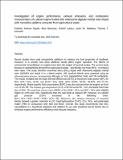| dc.description.abstract | Recent studies have used nanoparticle additions to enhance the fuel properties of biodiesel. However, it is unclear how these additives would affect engine operation. The effects of commercial nanoadditives on engines have been the subject of several studies. The current study focuses on nanoparticles derived from agricultural waste – specifically rice husk (RH) – to enhance their value. This study therefore examined silica (SiO2) doped with Adansonia digitata methyl ester (ADME) and tested it in a diesel engine. All nanofuel blends were prepared using an ultrasonication process, incorporating 400 ppm of SiO2 nanoparticles, fuels, and 1% surfactants. The results revealed that the brake thermal efficiencies (BTE) at maximum brake power (BP), for B20, B20 + SiO2, B100, and B100 + SiO2 fuels, were 29.9%, 28.2%, 28.44%, and 27.1%, respectively. Brake-specific fuel consumption (BSFC) was also reduced when the engine ran from 4 to 16 kW BP. The exhaust gas temperature (EGT) of B100 and B100 + SiO2 increased more than that of B20. The peak heat release rates (HRR) of the B100 + SiO2 and B20 + SiO2 were slightly higher by 2.9% and 2.6%, respectively than the neat B100 at medium BP. However, in-cylinder gas pressure (CGP) increased in the following order: B20 + SiO2 < B20 < B100 < B100 + SiO2 < B0. Moreover, the exhaust emissions of nanofuel blends showed a greater reduction in CO, total hydrocarbon (THC), CO2, NOX, and particulate matter (PM) in comparison with B20 and B100. Overall, this study recommends that SiO2 nanoadditive is a beneficial substitute fuel additive to use with biodiesel and its blends due to enhanced engine performance efficiency and reduced emissions. | en_US |

